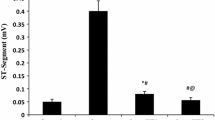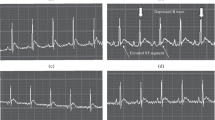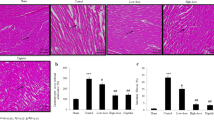Abstract
The present study was designed to evaluate the cardioprotective effect of Tunisian flaxseed oil (Linum usitatissimum) against isoproterenol-induced myocardial infarction in rats by studying hypertensive and cardiac damage markers especially electrocardiographic changes and troponin T serum level. In vitro, the extracted oil showed an important inhibition of angiotensin converting enzyme (ACE) with an IC50 = 85.96 μg/ml. According to chemical analysis, this extract is composed essentially of alpha linolenic acid (ALA), an n-3 polyunsaturated fatty acid (58.59 %). Male rats were randomly divided into three groups, namely control (C), isoproterenol (ISO), and isoproterenol-treated group with flaxseed oil (FO + ISO). Isoproterenol injection showed changes in ECG pattern, including ST-segment elevation (diagnostic of myocardial infarction), increase in the serum levels of Troponin T and cardiac injury markers (creatine kinase-MB (CK-MB), lactate dehydrogenase (LDH), alkaline phosphatase (ALP), aspartate transaminase (AST), and alanine transaminase (ALT)). However, Linum oil pre-co-treatment prevented almost all the parameters isoproterenol-induced myocardial infarction in rats. Results of the present study proved that flaxseed oil has a significant effect by heart protection against isoproterenol-induced myocardial infarction through beneficial effect of the important fraction of ALA.


Similar content being viewed by others
References
Balazs T, Ferrans VJ (1978) Cardiac lesions induced by chemicals. Environ Health Perspect 26:181–191
Baroldi G (1974) Myocardial necrosis: the need for definition. J Mol Cell Cardiol 6:401–402
Chen JP, Stavro M, Thompson LU (2002) Dietary flaxseed inhibits human breast cancer growth and metastasis and down regulates expression of insulin-like growth factor and epidermal growth factor receptor. Nutr Cancer 43:187–192
Collins TF, Sprando RL, Black TN, Olejnik N, Wiesenfeld PW, Babu US, Bryant M, Flynn TJ, Ruggles DI (2003) Effects of flaxseed and defatted flaxseed meal on reproduction and development in rats. Food Chem Toxicol 41:819–834
Finegold JA, Asaria P, Francis DP (2013) Mortality from ischaemic heart disease by country, region, and age: Statistics from World Health Organisation and United Nations. Int J Cardiol 168:934–945
Ganapathy P, Rajadurai M, Ashokumar N (2014) Cardioprotective effect of β-sitosterol on lipid peroxides and antioxidant in isoproterenol-induced myocardial infarction in rats: a histopathological study. Int J Curr Res 6:7260–7266
Grimm D, Elsner D, Schunkert H, Pfeifer M, Griese D, Bruckschlegel G, Muders F, Riegger GA, Kromer EP (1998) Development of heart failure following isoproterenol administration in the rat: role of renin-angiotensin system. Cardiovasc Res 37:91–100
Herchi W, Harrabi S, Sebei K, Rochut S, Boukhchina S, Pepe C, Kallel H (2009) Phytosterols accumulation in the seeds of Linum usitatissimum L. Plant Physiol Biochem 47:880–885
Jaffe AS, Ravkilde J, Roberts R, Naslund U, Apple FS, Galvani M, Katus H (2000) It’s time for a change to a troponin standard. Circulation 102:1216–1220
Karthick M, Prince P (2006) Preventive effect of rutin, a bioflavonoid, on lipid peroxides and antioxidants in ISO-induced myocardial infarction in rats. J Pharm Pharmacol 58:701–707
Kinniry P, Amrani Y, Vachani A, Solomides CC, Arguiri E, Workman A, Carter J, Christofidou-Solomidou M (2006) Dietary flaxseed supplementation ameliorates inflammation and oxidative tissue damage in experimental models of acute lung injury in mice. J Nutr 136:1545–1551
Lozano R, Naghavi M, Foreman K, Lim S, Shibuya K, Aboyans V, Cross M (2012) Global and regional mortality from 235 causes of death for 20 age groups in 1990 and 2010: a systematic analysis for the Global Burden of Disease Study 2010. Lancet 380:2095–2128
Marambe KH, Shand PJ, Wanasundara JP (2011) Release of angiotensin I-converting enzyme inhibitory peptides from flaxseed (Linum usitatissimum L.) protein under simulated gastrointestinal digestion. J Agric Food Chem 59:9596–604
Meier MA, Al-Badr WH, Cooper JV, Klin-Rogers EM, Smith DE, Eagle KA et al (2002) The new definition of myocardial infarction: diagnostic and prognostic implications in patients with acute coronary syndromes. Arch Intern Med 162:1585–1589
Milei J, Nunez RG, Rapaport M (1978) Pathogenesis of isoproterenol induced myocardial lesions its relation to human coagulate myocytolysis. Cardiology 63:139–151
Morrow DA, Cannon CP, Jesse RL, Newby LK, Ravnkilde J, Storrow AB, Wu AH, Tang W (2007) National Academy of Clinical Biochemistry Laboratory Medicine Practice Guidelines: clinical characteristics and utilization of biochemical markers of acute coronary syndromes. Clin Chem 53:552–574
Mozaffarian D (2005) Does alpha-linolenic acid intake reduce the risk of coronary heart disease? A review of the evidence. Altern Ther Health Med 11:24–30
Nora JJ, Lortscher RH, Spangler RD, Nora AH, Kimberling WJ (1980) Genetic-epidemiologic study of early-onset ischemic heart disease. Circulation 61:503–508
Panda VS, Naik SR (2008) Cardioprotective activity of Ginkgo biloba phytosomes in isoproterenol induced myocardial necrosis in rats: a biochemical and histoarchitectural evaluation. Exp Toxicol Pathol 60:397–404
Patel DK, Desai SN, Gandhi HP, Devkar RV, Ramachandran AV (2012) Cardioprotective effect of Coriandrum sativum L. on isoproterenol induced myocardial necrosis in rats. Food Chem Toxicol 50:3120–3125
Plat J, Mensink RP (2005) Plant stanol and sterol esters in the control of blood cholesterol levels: mechanism and safety aspects. Am J Cardiol 96:15–22
Prasad K (1997) Dietary flax seed in prevention of hypercholesterolemia atherosclerosis. Atherosclerosis 132:69–76
Prasad K (2000) Oxidative stress as a mechanism of diabetes in diabetic BB prone rats: effect of secoisolariciresinol diglucoside (SDG). Mol Cell Biochem 209:89–96
Quinones M, Miguel M, Aleixandre A (2013) Beneficial effects of polyphenols on cardiovascular disease. Pharmacol Res 68:125–131
Rajadurai M, Mainzen Prince PS (2007) Preventive effect of naringin on isoproterenol-induced cardiotoxicity in Wistar rats: an in vivo and in vitro study. Toxicology 232:216–225
Rajadurai M, Stanely Mainzen Prince P (2007) Preventive effect of naringin on cardiac markers, electrocardiographic patterns and lysosomal hydrolases in normal and isoproterenol-induced myocardial infarction in Wistar rats. Toxicology 230:178–188
Rajesh KN, Murthy C, Kumar KM, Madhusudhan B, Ravishankar GA (2006) Antioxidant potentials of flaxseed by in vivo model. J Agric Food Chem 54:3794–3799
Roger VL, Killian JM, Weston SA, Jaffe AS, Kors J, Santrach PJ, Jacobsen SJ (2006) Redefinition of myocardial infarction: prospective evaluation in the community. Circulation 114:790–797
Rona G (1985) Catecholamine cardiotoxicity. J Mol Cell Cardiol 17:291–306
Simopoulos AP (2002) The importance of the ratio of omega-6/omega-3 essential fatty acids. Biomed Pharmacother 56:365–379
Simopoulos AP (2008) The importance of the omega-6/omega-3 fatty acid ratio in cardiovascular disease and other chronic diseases. Exp Biol Med 233:674–688
Singal PK, Beamish RE, Dhalla NS (1983) Potential oxidative pathways of catecholamines in the formation of lipid peroxides and genesis of heart disease. Adv Exp Med Biol 161:391–401
Wu JP, Aluko RE, Muir AD (2002) Improved method for direct high performance liquid chromatography assay of angiotensin-converting enzyme-catalyzed reactions. J Chromatogr 950:125–30
Zanwar AA, Hegde MV, Bodhankar SL (2011) Cardioprotective activity of flax lignan concentrate extracted from seeds of Linum usitatissimum in isoprenalin induced myocardial necrosis in rats. Interdisc Toxicol 4(2):90–97
Zhou R, Xu Q, Zheng P, Yan L, Zheng J, Dai G (2008) Cardioprotective effect of fluvastatin on isoproterenol-induced myocardial infarction in rat. Eur J Pharmacol 586:244–250
Acknowledgements
This research was supported by the Tunisian Ministry of Higher Education and Scientific Research and the Tunisian Ministry of Public Health. Authors wish to thank Mbarek Nasri and Chedly Tmar for their assistance and cooperation.
Conflict of interests
The authors declare no conflict of interest.
Author information
Authors and Affiliations
Corresponding author
Additional information
Amal Derbali and Kais Mnafgui contributed equally to this work.
Rights and permissions
About this article
Cite this article
Derbali, A., Mnafgui, K., Affes, M. et al. Cardioprotective effect of linseed oil against isoproterenol-induced myocardial infarction in Wistar rats: a biochemical and electrocardiographic study. J Physiol Biochem 71, 281–288 (2015). https://doi.org/10.1007/s13105-015-0411-2
Received:
Accepted:
Published:
Issue Date:
DOI: https://doi.org/10.1007/s13105-015-0411-2




